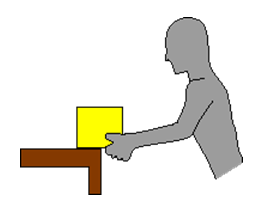Explain the Energy
Again, we have all heard about energy. When the alarm clock rings in the morning we roll over and say, “I do not want to get up, I have no energy this morning.” In science, energy is the ability to do work and there are different kinds. Potential energy is energy that is stored and waiting to be used and kinetic energy is energy in movement.

Now we’re going to assume something that is not true to make the problems simpler. We’re going to ignore friction. “How can you do that,” you say? There is always some friction in life and especially in physics. Well, physics is not just what happens in real life but also a set of rules to figure out how the world works. Basically, we can choose to leave out friction to just look at how other things effect what happens.
Ignoring friction, if you do work on an object, you add to its energy a number of joules equal to the work you just did. Such as, if you throw a ball, the work you do with your arm - the force acting through a distance to speed up the ball - is changed into motion of the ball. So, your arm’s work is converted into kinetic energy of the ball.
If you lift a box to a tabletop, you do work - pull up on the box to move it up to table height - and give the box more potential energy. Where is the potential energy? Consider this, would it hurt if I set the box on your toe? Would it hurt more if I dropped the box from table height onto your toe? Of course it would. If it can hurt your toe more, it has more “potential to hurt” or more potential energy. If it stays on the table, the energy stays potential, stored ready to be used, until I push it off the table. If I threw it down from table height, it could hurt even worse. Now, it has the potential energy from its height, plus kinetic energy from my throwing it - more energy, even more “ouch”.
Energy due to the height of an object above the Earth’s surface is called gravitational potential energy. There are other ways to store energy too, chemically, electrically, or with a spring.